This classic Thai green curry is my most popular recipe with over 5 million views on YouTube. It uses traditional methods that deliver bold flavours, but takes only 35 minutes to make. It's made with tender-braised chicken and Thai eggplant, but I also offer options for chicken breast and other veggies. Don't skip my simple hacks for "enhancing" store bought curry paste to amplify the curry's aroma and umami! Plus, it's gluten and dairy free!
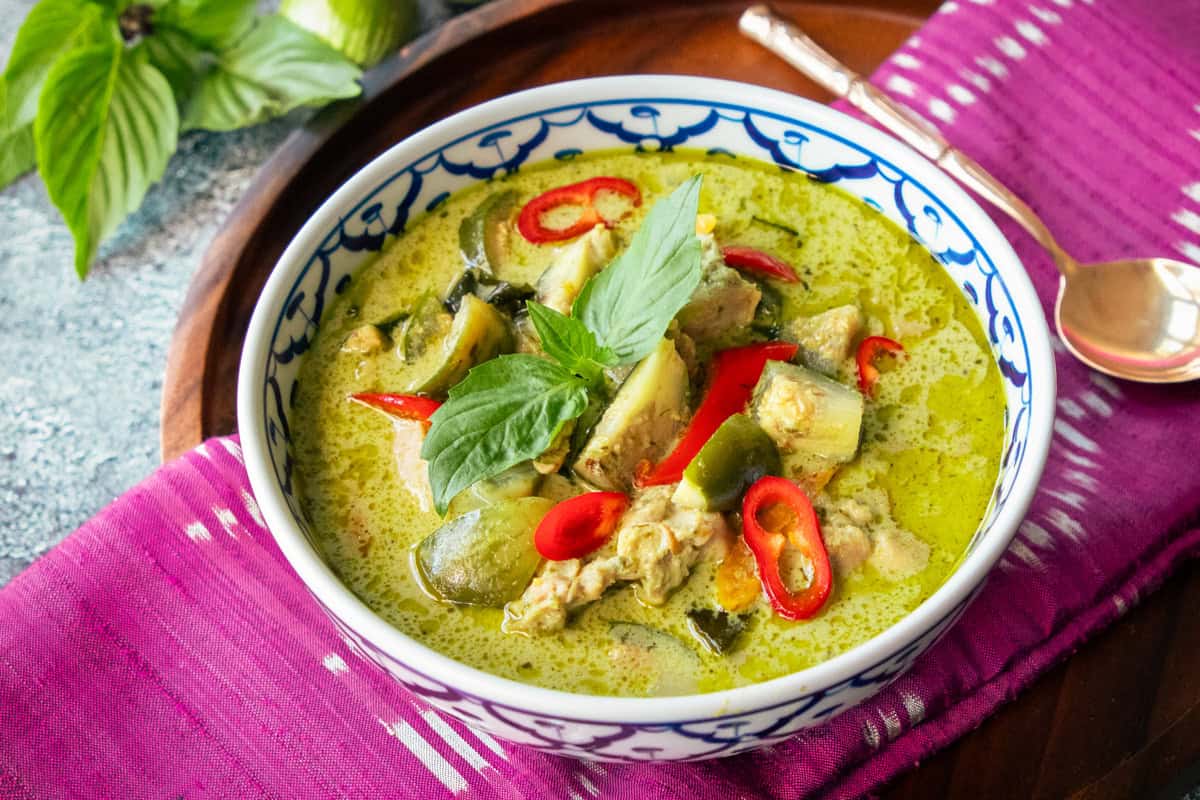
But first, what is a green curry, anyway?
In Thai cuisine, green curry is a coconut-milk-based curry that can be made with many different proteins, but chicken is the most common. The green colour comes primarily from the use of fresh green chilies in the curry paste, which makes it unique in this regard since most other Thai curries use red chilies in the paste.
In Thai, green curry is called gaeng kiew waan แกงเขียวหวาน which literally means "sweet green curry," though it is not particularly sweet. It is thought that the "sweet" refers to the colour green, indicating a softer shade of pastel green.
It is one of the most popular, if not THE most popular curry in Thailand. It's served in just about every context from home cooking to street food to fine dining. We eat it with jasmine rice, rice noodles, and even roti. Some people even eat it with spaghetti! It is truly an integral part of Thai cuisine, and a great curry to make for a Thai food beginner.
Ingredients and Notes
Here are ingredients you'll need and important notes about them. For amounts, see the full recipe card below. And if you are DIY-minded and have time, here's my homemade green curry paste recipe.
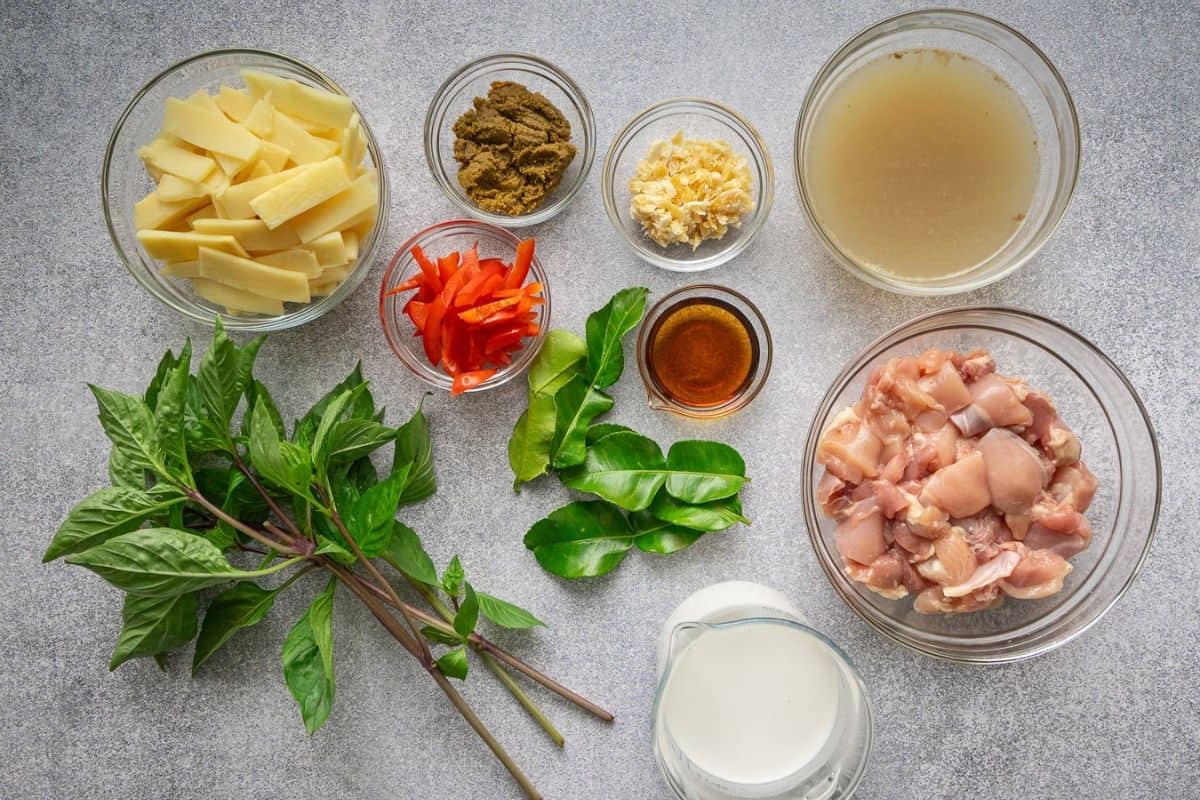
- Green curry paste, store-bought is fine, but also see my "enhancements" below to make it even better. It is extremely important to use a good brand; I recommend Maeploy, and if not available then Aroy-D is my second pick. Do not use Thai Kitchen brand as it is very weak, or if you must, double the amount called for. See my curry paste review for details.
If using my homemade green curry paste, you can put the entire batch of paste into this curry recipe. - Boneless skinless chicken thighs. Chicken thighs do make the best tasting green curry, but if you must use chicken breast, the method is a little different and I've provided the details in the recipe card.
- Full fat coconut milk, I recommend Aroy-D in paper carton.
- Chicken stock, unsalted. Store bought is fine but you can also use my Thai style chicken stock recipe.
- Fish sauce
- Palm sugar, or sub granulated or light brown sugar.
- Makrut lime leaves
- Red bell pepper, julienned, or any kind of red or orange peppers. This is added just for colour.
- Thai basil
- Vegetable options: Thai eggplant, bamboo shoots, and winter melon are traditional. Cut Thai eggplants into bite-sized wedges and keep them in water if not using right away so they don't turn brown. Bamboo shoots come ready to use in a can and just need a rinse. Winter melon simply need to be peeled, seeded, and 1-inch cubed. You can sub any other veggies that are "soup-friendly" and adjust the cooking time accordingly.
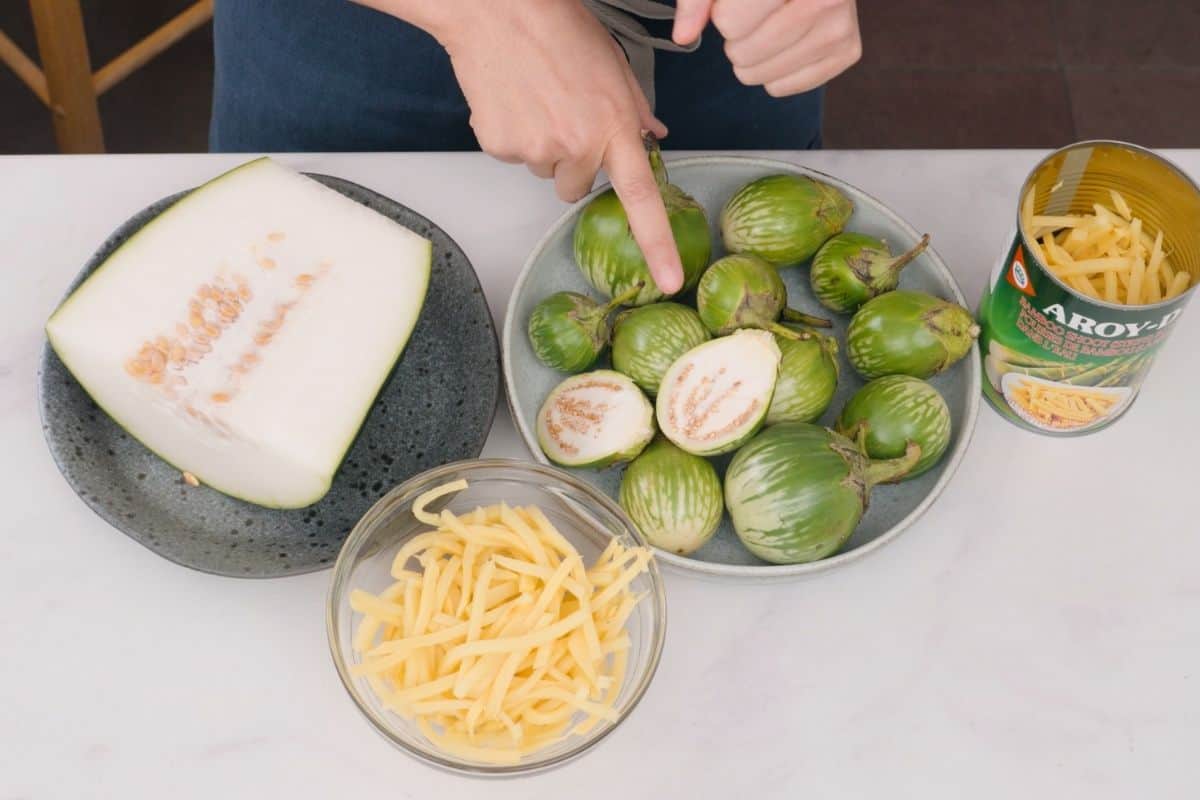
Enhancing Store Bought Curry Paste: Optional But Recommended
If you use one of my recommended green curry paste brands, you'll get good results. BUT, there are a few simple things you can add to take it to the next level. Add one or all 3 things; they really do make a big difference!
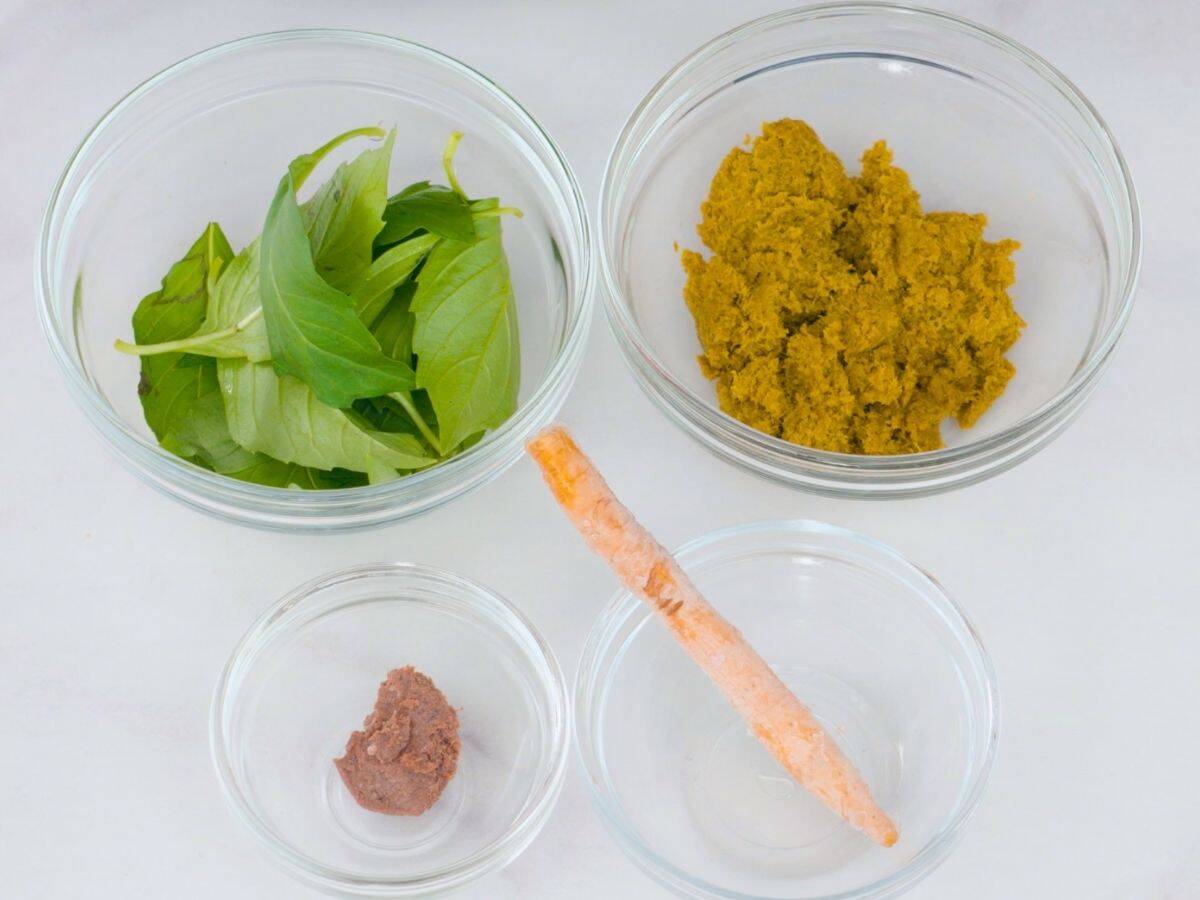
- Shrimp paste. If you only do one thing to enhance your paste, let it be this. Thai fermented shrimp paste, gapi in Thai, will add depth and umami that I promise you will love. Shrimp paste is always added to traditional Thai curry pastes, but most commercial pastes omit it in order to make it vegetarian friendly. If your brand already contains shrimp paste, I recommend you add more anyway because they don't add much of it. You can also sub Indonesian/Malaysian shrimp paste (called terasi or belacan). If you're vegetarian, add miso paste.
- Thai basil. I add Thai basil to boost the green colour which makes the curry much prettier. The green in green curry traditionally comes from green chilies, but because brands don't want to make their product overly spicy, they add very little green chilies, leading to a rather pale green colour in the final dish. We can fix this simply by adding any dark green leaves to the paste, so I opt for Thai basil since it's already and ingredient you'll need. If you love super spicy food, you can also add green chilies such as serranos or jalapenos in addition to the basil.
- Grachai /krachai (fingerroot). This is an aromatic rhizome that we often add to green curry, but many commercial brands leave it out. I think it makes the curry much better! Fresh or frozen is great, but they also come brined in a glass jar (pic below) which also works perfectly. Look for them at Southeast Asian grocery stores.
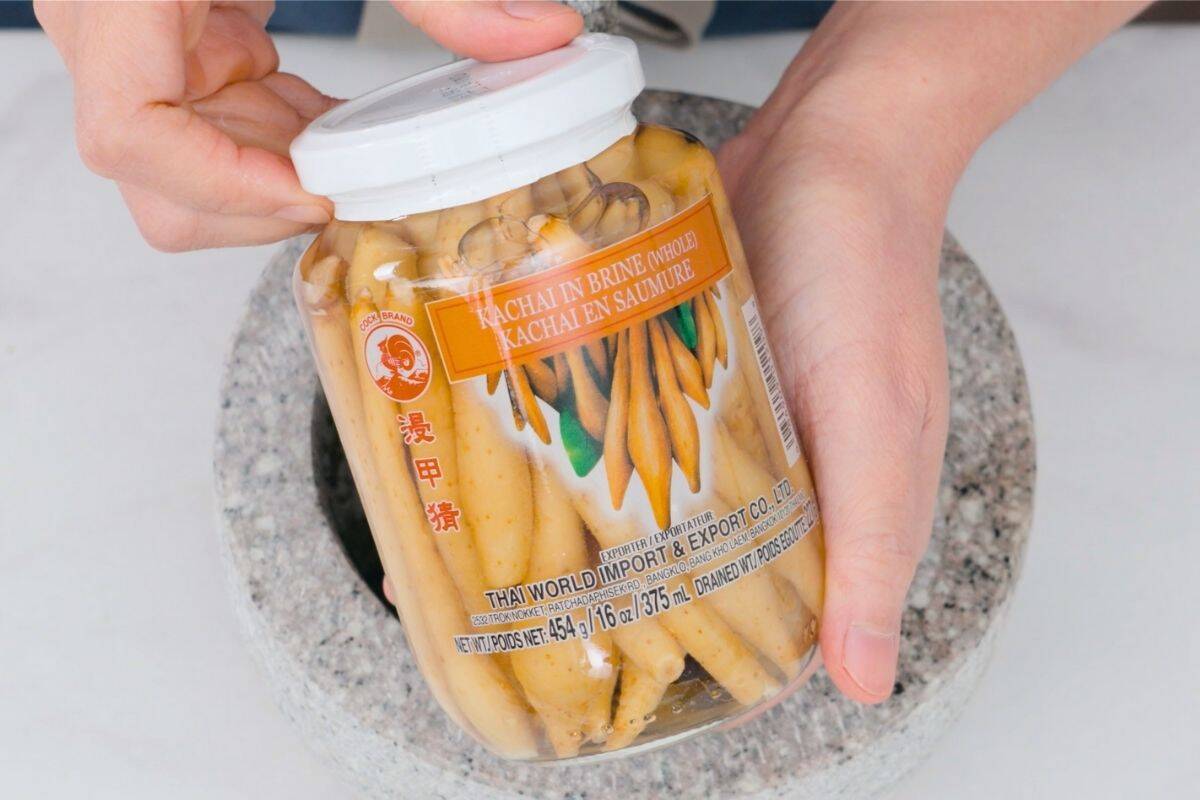
Step-By-Step
Here's a bird's eye view of the process, but to ensure success, I highly recommend watching the video tutorial!

- Optional if you're enhancing the curry paste: Pound julienned Thai basil and fingerroot in a mortar and pestle into a paste.
- Then add the shrimp paste and the green curry paste and pound to mix.
- Bring about ¾ cup of the coconut milk to a full boil then add the curry paste and cook over medium high heat, stirring frequently.
- Keep cooking until the coconut oil starts to separate away from the paste as you can see in the image above. *If the paste is super thick and no oil separation occurs, that's fine, you can just move on.

- Add the chicken thigh and mix it with the curry paste, then add the coconut milk, chicken stock, half of the fish sauce and palm sugar. (For chicken breast modification, see the recipe card below).
- Twist and bruise makrut lime leaves, tear them into chunks and discard the center stems. Add them to the curry and simmer for 10 minutes. (If using winter melon, add them at this stage as they take 10 mins to cook.)
- Add the Thai eggplant and keep stirring, pushing them into the curry for 1 minute, then let them cook without stirring for 2 more minutes until a fork can go through with slight resistance, then turn off the heat. If using bamboo shoots, simply let them cook for 1 minute to heat through.
- Add the red peppers and Thai basil and stir just until wilted. Taste and adjust seasoning with more fish sauce as needed, then serve with jasmine rice!
Important Tip: If Using a New Curry Paste Brand
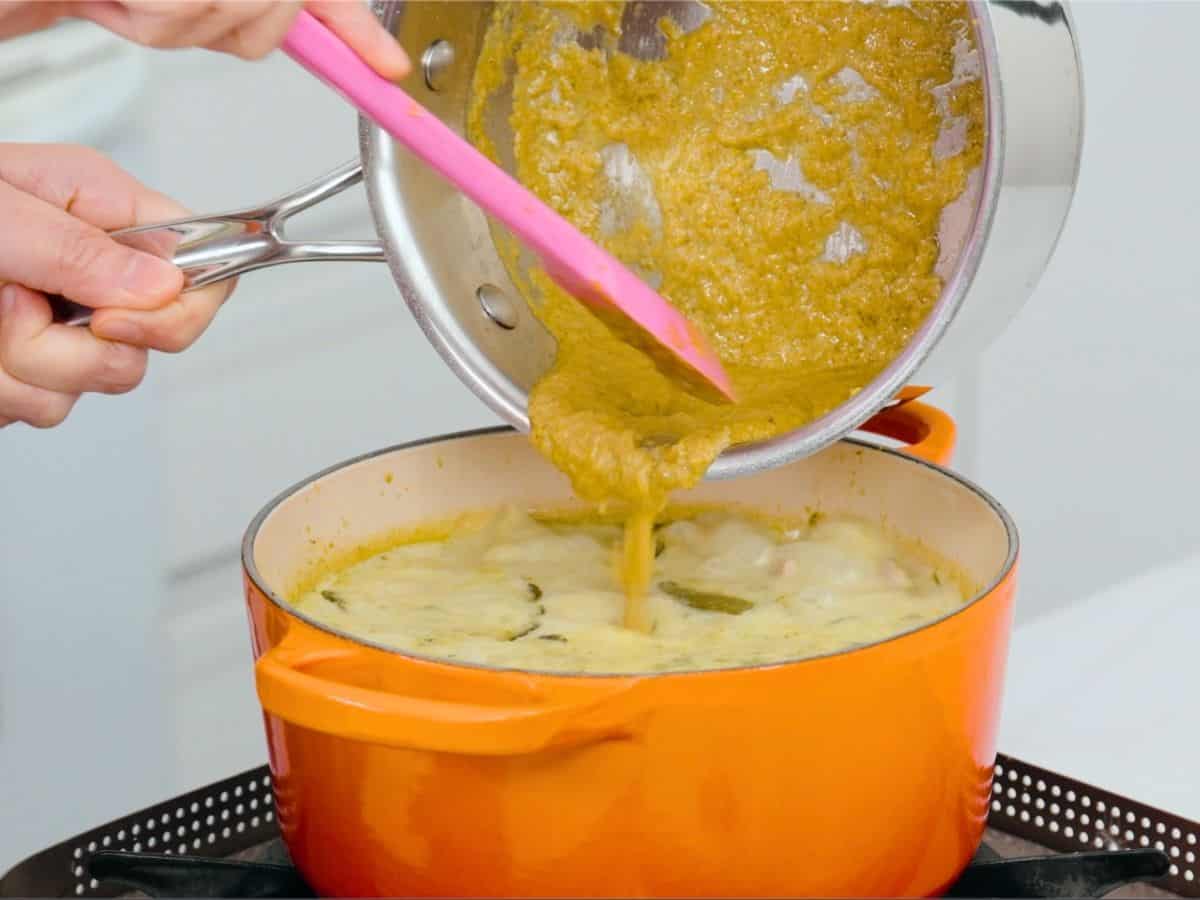
The strength of each curry paste brand varies HUGELY. So if you are using a brand for the first time, you won't really know how much curry paste to add. So start out with the amount called for in the recipe, then there is one extra step you will need to do:
After the chicken and seasonings have gone in for a couple of minutes, taste the sauce and see if you are happy with the strength of the sauce. Is it flavourful? Aromatic? Is it spicy enough? If it tastes weak, you will need to add more curry paste. But don't just scoop in raw curry paste, you will need to cook it off first!
Simply sauté an additional amount of curry paste in a little bit of neutral oil for a few minutes, then dissolve it with a little coconut milk or water so it's pourable, then pour it into the curry pot. Taste and adjust again as needed.
Serving Green Curry with Rice Noodles (kanom jeen gaeng kiew waan)
Aside from jasmine rice, which is the classic accompaniment. green curry is also commonly served over rice vermicelli or kanom jeen. Make sure you get the right type, what you want is VIETNAMESE rice vermicelli, which are round sticks and come in various sizes.
Any size works, but my preference is for smaller ones. You simply need to boil them in water for 7-10 minutes until tender (timing depends on the size) then fish them out and place in a bowl of cold tap water to stop cooking. Drain and separate them into serving bowls immediately while they are wet and can be easily separated. You can watch my kanom jeen namya tutorial as a guide.
You can also sub Japanese somen noodles which are made from wheat, but once cooked they have a similar enough texture. They only need 2 minutes to cook.
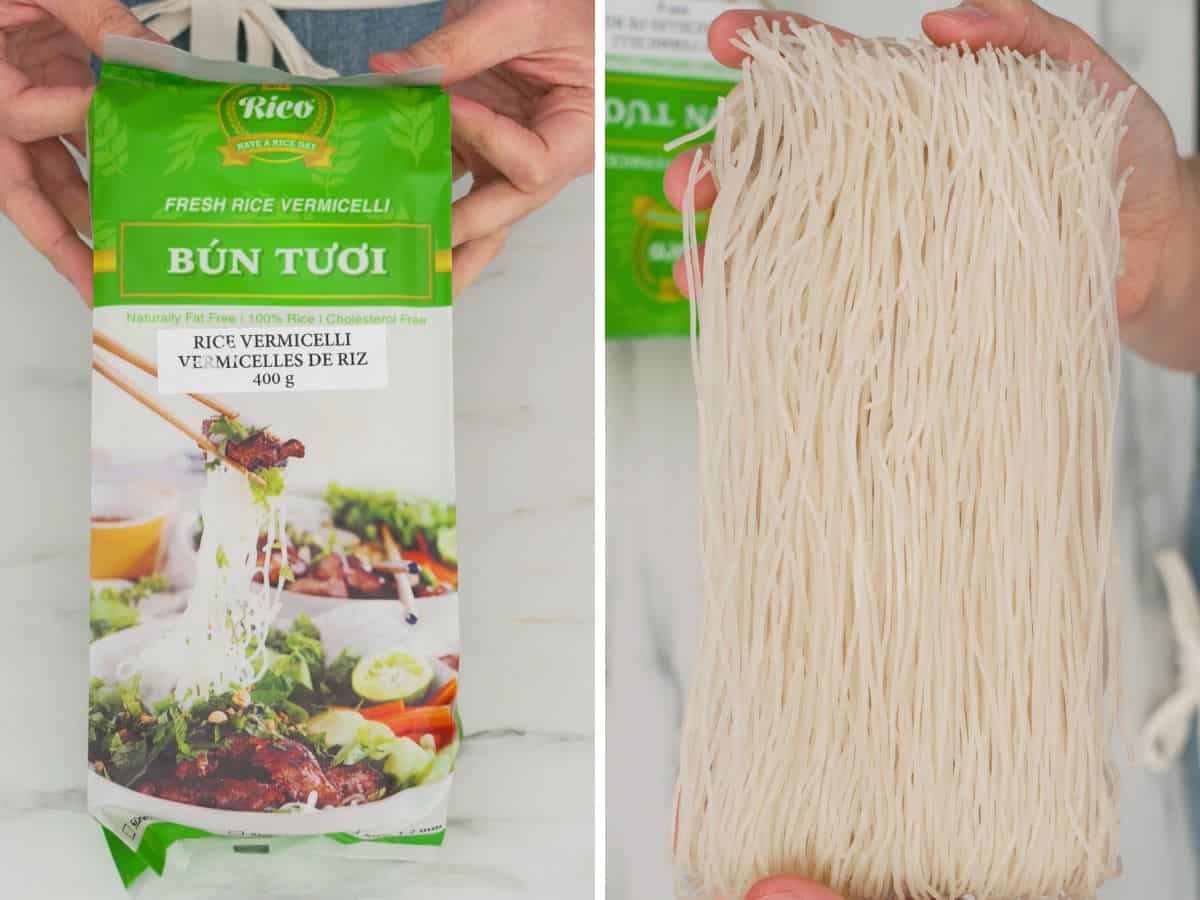
Storage and Reheating
Green curry will last in your fridge for up to a week and it can be reheated in the microwave. If you're using eggplant, they may overcook during reheating so try not to overheat it. If you want to make curry to freeze, see my post on how to freeze a Thai curry.
Save this recipe!
Other Classic Thai Curries To Try
Once you've made green curry, other Thai curries will be easy because the basic steps are the same. You're just changing up the curry paste, the meat and veggies, and modifying the process slightly to match the different ingredients used!
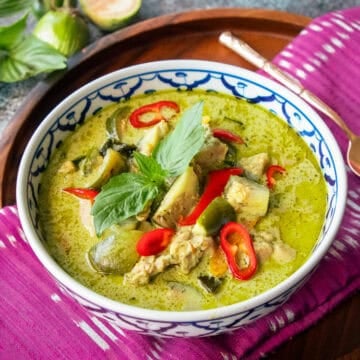
Authentic Thai Green Curry Chicken
Equipment
- mortar and pestle optional
Save this recipe!
Ingredients
- 1¾ cups coconut milk, divided
- 1 cup chicken stock, unsalted
- 1 lb chicken thigh, boneless, skinless, 1-inch pieces (see note 1)
- 2 Tablespoons finely chopped palm sugar, or light brown sugar
- 1 ½ - 2 Tablespoons fish sauce
- 5 makrut lime leaves, (aka kaffir lime leaves)
- ½ lb Thai eggplant, or sub a can of bamboo shoots (see note 2)
- 1 cup Thai basil leaves
- ¼ red bell pepper, or another mild red pepper, julienned
- Jasmine rice for serving
"Enhanced" Green Curry Paste
- 15 Thai basil leaves, finely julienned
- 1 piece fingerroot (krachai), optional
- 1 teaspoon fermented shrimp paste (gapi)
- 3 ½ Tablespoons green curry paste, store bought or homemade (see note 3).
Notes
- If using chicken breasts, cut into ½-inch thick, bite-sized slices, and marinate in 1 tablespoon of fish sauce. Follow instructions specific to chicken breasts.
- If using bamboo shoots, drain and rinse well. You can sub other veggies of your choice, making sure to adjust cooking time as needed.
- I recommend Maeploy brand green curry paste, or Aroy-D if not available. Do not use Thai Kitchen brand. See: My Green Curry Paste Review.
FULL VIDEO TUTORIAL
All my recipes come with step-by-step video tutorials with extra tips not mentioned in the blog post, so make sure you watch the video to ensure success. If you enjoy them, consider subscribing to the YouTube Channel to not miss an episode. Thank you!
Subscribe to my YouTube ChannelInstructions
For "Enhanced" Green Curry Paste
- This is an optional step but highly recommended to improve the flavour and colour of your curry. In a mortar and pestle, pound julienned Thai basil into a fine paste. Add grachai and pound into a paste. Add the shrimp paste and green curry paste and pound to mix. Alternatively, you can add the basil, grachai, and shrimp paste to a blender, and blend it with some of the chicken stock until smooth, and you'll just need to pour this into the curry with the rest of the stock.1 piece fingerroot (krachai), 1 teaspoon fermented shrimp paste (gapi), 3 ½ Tablespoons green curry paste, 15 Thai basil leaves
For the Green Curry
- In a heavy-bottomed pot, bring about ¾ cup of the coconut milk to a full boil over medium heat. Add the curry paste and sauté, stirring frequently, until coconut oil starts to separate from the paste, 3-5 minutes. If the paste is super thick and no oil separation occurs, you can move on to the next step. *If the paste sticks to the bottom of the pan, you can deglaze with a little bit of the remaining coconut milk or stock.1¾ cups coconut milk
- Add chicken thigh and stir to mix with the paste. (If using chicken breast, see modification below)1 lb chicken thigh
- Add the chicken stock, remaining 1 cup of coconut milk, palm sugar and 1 Tablespoon of the fish sauce. Grab the makrut lime leaves and twist them to bruise and release aroma, then tear them into chunks and add them to the pot, discarding the center stems. Bring to a simmer and let simmer gently for 10-15 minutes or until the chicken is fork tender.*The lime leaves are for infusion only and not meant to be eaten when left in large pieces. They are traditionally left in the curry, but be sure to inform your guests not to eat them.1 cup chicken stock, 2 Tablespoons finely chopped palm sugar, 1 ½ - 2 Tablespoons fish sauce, 5 makrut lime leaves
- Meanwhile, if using Thai eggplant, cut them into bite-sized pieces; this could mean cutting into 6,8, or even 12 pieces depending on the size. Keep them submerged in water if not using soon to prevent browning.½ lb Thai eggplant
- Once the chicken is done simmering, add the Thai eggplant and keep pushing them into the curry for the first minute as they will turn brown if left to float in the beginning, and then you can leave them to cook for 2 minutes longer until the eggplant can be pierced through with a fork with a little resistance. Do not let the eggplant overcook.If using bamboo shoots, simply add them in and let them cook for a minute or so to heat up as they are already cooked (and they cannot be overcooked!)½ lb Thai eggplant
- Turn off the heat and add the red peppers and stir to mix, letting them cook gently in the residual heat. Then add the Thai basil and stir to mix. Taste and adjust seasoning with more of the fish sauce as needed. Serve with jasmine rice!*If you feel that the curry is weak and needs more curry paste, saute the additional curry paste in some oil in a small pot for a few minutes until aromatic, then add about a cup of the curry sauce to dissolve the paste and let it simmer for a few minutes, then stir it back into the curry.1 cup Thai basil leaves, Jasmine rice for serving, ¼ red bell pepper
If using chicken breast:
- Marinade the chicken in 1 tablespoon of fish sauce and let it sit while you make the curry. Follow instructions above but leave the chicken out until after the eggplant/bamboo shoots have been added. Add the chicken after the veg have been cooking for 1 minute, then let it to cook for about 2 minutes or until just done. Do not overcook.

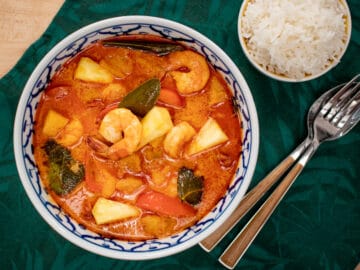
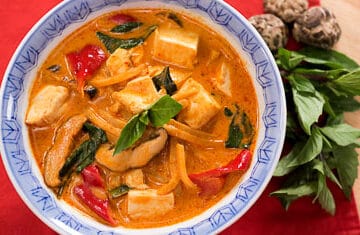
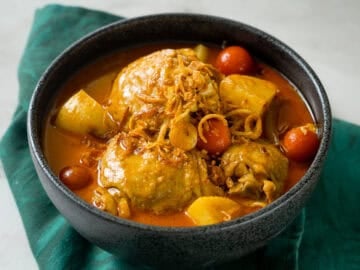
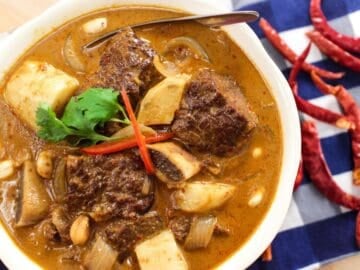
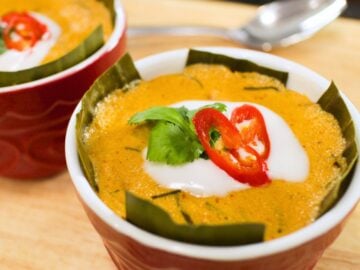

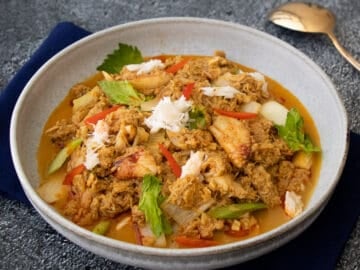
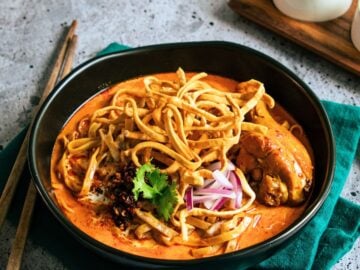
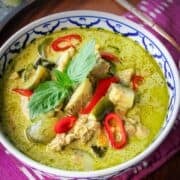
Thai in Norway says
Pai, this recipe is legendary. You have no idea how many times I've tried to eyeball this with no avail. I'm thai through and through, and my mom and my grandma never used measurements. So I thought I didn't need to. Turns out I did, and thank goodness you came through. Green curry is my favourite food in the world and I started to get worried that It'll never be as good as when my dear mom and grandma made it. Thank you from the bottom of my heart!!!
Lauren says
I never leave recipe reviews, but this green curry is fantastic. I first made it in September and it's been made almost weekly since then. I used dry kaffir lime leaves and light brown sugar because that's all I had at the time, but visited a Thai supermarket on the weekend and made it again today with palm sugar and fresh kaffir lime leaves and it's elevated the entire dish. Such a perfect recipe! I've always been disappointed in thai curries until I found this recipe! ❤️
Monsur Mannan says
This is probably the best Thai green curry I’ve had! Honestly we don’t order Thai green curry anymore from restaurant! This is our go to recipe! Anyone who has tried it when we make it says the same and immediately asks for the recipe!
Moony says
Love this technique for chicken green curry. It makes the chicken very flavorful. And versatile with any veggies you have in hand. I used the store bought paste, Mae Ploy (2 tablespoon) and have used My Thai Kitchen brand( the whole small jar) not too spicy for the family. My go to recipes for chicken green curry. Thank you, Pai.
Brit says
I loved this recipe! My one suggestion for others using a store-bought paste is to add fresh cilantro stems when you muddle the paste or add cilantro leaves at the end (I was using mae ploy). It just helps amplify the herby flavour and makes it taste a bit more fresh.
Dan says
I made a mild version this evening. I used a few green bird's eye chillies and a few padron peppers. These ensured an intense green colour without adding much bite. I also used fresh mooli (daikon) instead of bamboo shoots. I sliced it thin so it would cook quickly. The mooli brought a slight bitterness to the curry, but it was still most enjoyable.
Justin Hawkinson says
Hey Pailin. I've cooked about half your recipes and I've learned a lot. Here's my contribution. You can velvet chicken breast using a bit of water and tapioca starch similar to rad na preparation and add the diced chicken breast at the end of cook using residual heat to cook. In meals like this that develop complexity the next day using this method works perfectly. Super soft and curry soaked chicken. I've greatly reduced cooking time using this technique. I made your gaeng garee too the other day. I made the paste and everything. Now that i have the spices I'm going to experiment a bit and make chicken satay spring rolls because i think that would pair great and isn't traditional preparation. I think my neighbors will appreciate the creativity. Being a farang it's hard to get Thai people to accept different stuff. I made a tom kha mayonnaise for my fried chicken sandwiches and it was a flop. I think they'll like the spring roll idea though. One suuuuuper delicious Thai chicken dish i don't see in your recipes is khao tom gai saeb. I think people would love that.
Sara says
Can you freeze the paste
Made the curry it was lovely ☺️
Adam from HTK says
Hi Adam here and yep she freezes all her curry pastes when she makes large batches. 🙂 Cheers!
Gudrun flesberg says
love it thanks
Elpidio says
Thank you for this recipe, used the Maeploy green curry and it came out fantastic!
I am wondering if this recipe can be used with fish.
Gardener says
The Print Recipe link is broken. I am using Chrome on a Mac.
Adam from HTK says
Adam here and yep it is and thanks! Thanks for letting us know and we're on it! 🙂
mark E says
Great recipe.
Can the recipe be frozen after cooking?